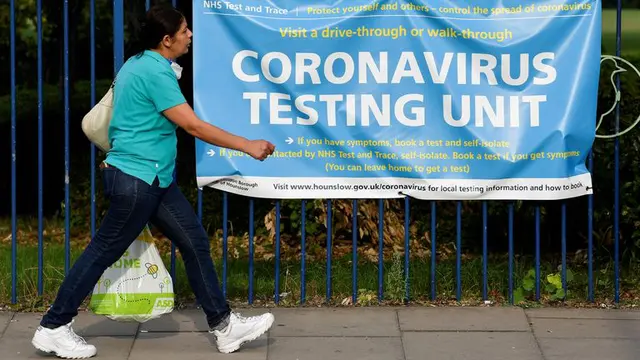As COVID-19 cases rise across the UK, the government's independent advisers have laid out the data showing where the UK is heading if no further measures are taken.
Sir Patrick Vallance, chief scientific adviser, and
Professor Chris Whitty
, England's chief medical officer, warned the UK has turned a corner "in a bad sense".
Their main message was that despite some areas not having as large an increase in cases as others, "this is all our problem" as cases are set to rise everywhere if people do not listen to guidance and restrictions.
Using data which they presented in a live broadcast without any politicians present, they showed how cases and deaths are at risk of rising rapidly across the UK.
They warned the UK is following Spain and France's rise in cases and deaths, with a graph showing steep increases in both countries since July and especially in September.
Sir Patrick said younger people in their 20s saw the first large increase in the two countries and this then spread to older people who have had to be admitted to hospital and then deaths have increased.
What does the UK data show?

Public Health England (PHE) data shows how the weekly rate of new cases per 100,000 people has increased for all ages since 29 July, but the 20-29 group has had the most significant rise, particularly since 30 August.
The lowest increase has been in children under 10 and the second oldest age bracket of 70-79.
Sir Patrick denied the increase is because more tests are being carried out as there is a higher rate of people testing positive.
Current PHE data shows cases are doubling roughly every seven days and if that continued there would be about 49,000 new daily cases by 13 October.
This would lead to "200 plus" deaths by mid-November, Sir Patrick said.

Nearly 8% of people - three million - in England may have been infected with
COVID-19
and also have antibodies.
This is slightly higher in cities and could be as high as 17% in London, Sir Patrick added, but means the "vast majority of the population remains susceptible".

Maps of England broken down by counties show where the largest and smallest increases in case rates have been.
Some areas in the North of England have seen the highest rises but Prof Whitty said there has been a significant rise in rates of transmission in lots of areas.
Smaller outbreaks in workplaces, for example, have become localised then grow into larger outbreaks - and this is happening all over the UK.
"Anywhere which was falling is now beginning to rise," Prof Whitty said.
"This is not somebody else's problem, this is all our problem."

Data shows there had been a steady fall in cases from April until 1 August when they levelled off, but since 1 September there has been a "sustained rise".
Prof Whitty warned if this continues the number of deaths will rise "on an exponential curve - doubling and doubling".
"We've, in a bad sense, literally turned a corner," he added.
"The seasons are against us. Late autumn and winter benefit respiratory diseases.
"This is a six-month problem."
He added that treatment of COVID-19 is better than it was at the start of the pandemic so death rates are reduced "but it will not eliminate them".

Sir Patrick said the world will learn to live with
**coronavirus **
until a vaccine is found.
He said "good progress" is being made on vaccines, with many showing immune responses and several in the very late stages of safety testing.
**:: Subscribe to Sophy Ridge on Sunday on **
Apple podcasts
**, Google podcasts
, Spotify
, Spreaker
**
The UK has access to vaccines and is in a good position to ensure supply is not an issue for any that work, Sir Patrick added.
He said a vaccine could possibly be available in small amounts before the end of the year for certain groups.
The first half of next year is more likely for a vaccine, he added.
 简体中文
简体中文



